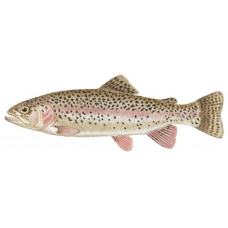Latin name
Oncorhynchus mykiss
Other names
Steelhead, rainbow, ’bow, redsides, Kamloops, redband trout, Eagle Lake trout, Kern River trout, Shasta trout, San Gorgonio trout, Nelson trout, Whitney trout, silver trout; Danish: regnbueørred; Finnish: kirjolohi; French: truite-arc-en-ciel; German: regenbogenforelle; Italian: trota iridea; Japanese: nijimasu; Russian: forel raduzhnaya; Spanish: trucha arco iris; Swedish: regnbåge; Turkish: alabalik türü.
Identification
Rainbow trout have the typical elongated and streamlined shape of salmonids, although body shape and coloration vary widely and reflect habitat, age, sex, and maturity. Body shape can range from slender to thick. The back can be blue-green to olive. Along each side near the midline is a reddish-pink stripe that can range from faint to brilliant. Undersides are usually silvery to pure white. Rainbow trout have numerous conspicuous black spots that may cover the entire body or be more numerous around the tail. Characteristically, the spots extend to the dorsal fin, adipose fin, and tail. On the tail, the spots are evenly distributed in an orderly pattern. Spots may be present on any of the lower fins. Rainbow trout can be identified by the 8-12 rays in the anal fin, the mouth not extending beyond the back of the eye, and the lack of teeth at the base of the tongue. Coloration varies greatly with size, habitat, and spawning season. Stream dwellers and spawners tend to have the darkest and brightest colors and markings. River and stream dwellers usually show the most intense coloration with pink stripes and the strongest spots, followed by rainbows from lakes and lake-river systems.
Distribution
Rainbow trout are found along the west coast of North America from southern Alaska to Durango, Mexico, and inland to central Alberta in Canada and Idaho and Nevada in the United States. It is widely distributed in the lower provinces of Canada, the Great Lakes region, and the northeastern United States to the Atlantic coast and south through the Appalachian Mountains to northern Georgia and Alabama, in the western United States east to western Texas, and sporadically in the central United States south of the Great Lakes.
Habitat
Although rainbows do well in large lakes with cool, deep water, they prefer moderately flowing streams with plenty of cover and deep pools. In most streams, they can be found in areas of fast current, at the edge of strong currents, at the head of rapids, or in strong riffles. They prefer water temperatures of 55° to 64°F, but can tolerate water as warm as 70°F.
Size
In general, rainbows that live in streams typically weigh about a pound, while fish from large rivers and lakes typically weigh between 2 and 4 pounds. Rainbows that have migrated to a large inland lake, such as one of the Great Lakes, can reach double-digit weights, although most weigh 7 to 10 pounds, and saltwater fish also become heavyweights. The largest non-anadromous rainbow trout in North America are currently found in the waters of Alaska and British Columbia. World records are held for all varieties of rainbow trout as one species, so the anadromous form dominates the record books, including specimens from 20 to over 30 pounds. They can live as long as 11 years, but typically have a life span of 4 to 6 years.
Life history and Behavior
Most rainbow trout spawn in the spring in small tributaries of rivers, inlets or outlets of lakes. The frequency of spawning varies from annually to once every 3 years. Rainbow trout usually return to the streams where they hatched. In late winter or early spring, as water temperatures rise, mature adults usually seek out shallow gravel channels in their stream or a suitable stream with clear water that flows into their lake. Spawning occurs from late winter or early spring to early summer. The female uses her tail to prepare a nest (redd) that is 4 to 12 inches deep and 10 to 15 inches in diameter. Eggs are laid in the nest, fertilized by the male, and covered with gravel. Hatching usually occurs a few weeks to 4 months after spawning, depending on water temperature. Small trout gather in groups and seek shelter along stream edges or sheltered lake shores, feeding on crustaceans, plant material, aquatic insects and their larvae. They breed in such habitats for the first 2-3 years, then move to larger waters of lakes and streams and switch to feeding on fish, salmon carcasses, eggs, and even small mammals.
Food and feeding habits
Rainbows eat a variety of foods, mostly insects, crustaceans, snails, leeches, and other fish when available.
Reproduction
No information
| Classification | |
| Phylum | Chordata |
| Class | Actinopterygii |
| Squad | Salmoniformes |
| Family | Salmonidae |
| Genus | Oncorhynchus |
| Species | O. mykiss |
| Features | |
| Conservation status | Secure |
| Habitat | Pelagic |
| Life span, years | 11 |
| Maximum body weight, kg | 9 |
| Maximum length, cm | 50 |
| Sailing speed, m/s | No information |
| Threat to people | Edible |
| Way of eating | Predator |



